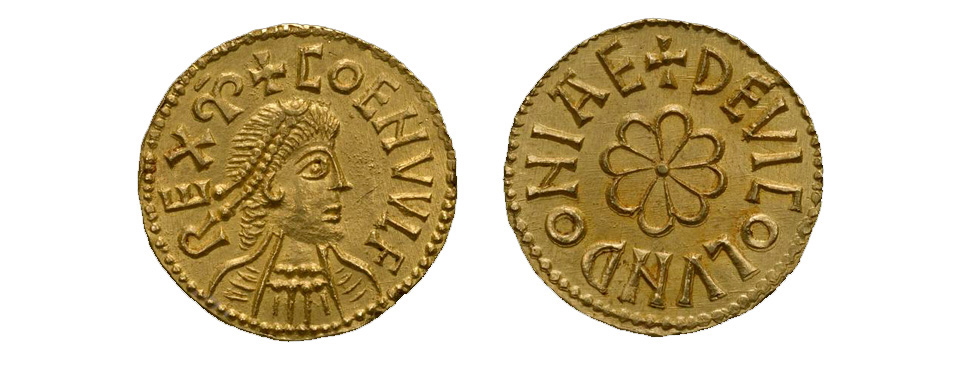The early Saxon settlers and the town of Lundenwic

This gold ‘mancus’ coin is from the reign of King Coenwulf of Mercia and Kent (796-821) stating DE VICO LVNDONIAE (from the trading place of London) when the Saxon settlement was to the west of the old walled city. London was one of several towns minting coins during that period. © Trustees of the British Museum
After the Roman empire disintegrated and the means to maintain the road system ended the River Thames was once more the main route of transport and communication in the London area. The Romans had sophisticated ocean-going ships and had created an embankment in Londinium, with jetties and wharves from which to load and unload. The Saxons did not possess the knowledge of how to maintain roads nor how to build large and sophisticated vessels. Even their biggest boats were designed to be pulled up onto a beach. They began to berth their ships at low tide on the gently sloping foreshore just to the west of the old town, where the river suddenly swings southwards in a large curve near the modern-day Charing Cross station. Traders arrived by boat from along the river or around the coast, moored up, and as the tide went out allowed the boat to berth on the muddy bank. Goods were sold and purchased directly from the boats. Other such beach markets developed at locations along the river at Woolwich, Greenwich, Twickenham and Hampton Wick.
A new community known as Lundenwic grew at the modern Charing Cross from the mid-7th century and from the simple start of pulling boats onto the sloping bank a settlement and small port developed in the area of modern-day Covent Garden, Strand and Trafalgar Square. There is a written reference from around 673 of “the port of London where ships tie up” and the historian Bede wrote of a Frisian trader buying slaves at London in 679. ‘Wic’ was the Saxon word for trading place, indicating that Lundenwic developed primarily for that purpose.
The lack of exotic items found in excavations shows that during the early stages of the development of Lundenwic, from around 630 until the mid-8th century, trade was quite local in its nature. Most goods brought to the market were probably from further along the river or nearby coastal villages. It is likely that the inhabitants survived mainly on grain, meat, fish, hay, timber and wool from the immediate hinterland. Local farmers visited the market from up and down the river to buy and sell produce, arriving in small punts that were dug out from the trunk of a tree, between two and four metres in length. These were sufficient to carry up to about four people or several animal carcasses and were propelled by a pole or paddle. Long distance traders arrived in ships made from oak planks of between twenty and thirty metres in length powered by a sail and oars and steered by an oar.
Even at that stage money was required to buy and sell goods and 7th century gold coins known as ‘thrymsas’ have been found at other places bearing the name ‘LONDINIU or ‘LONDENVS’, showing that a mint had already been established at Lundenwic. During the late 8th century silver penny coins were being minted there for the Mercian kings bearing the inscription ‘LUNDINIA’.
By the 8th century the population of Lundenwic had grown in size and goods were being traded with more distant ports such as Ipswich, Norwich, Eorforwic (York), Hamwic (Southampton), Wijk-bii-Duurstede in the Netherlands at the mouth of the Rhine, Sliaswich (Schleswig) in Germany, Quentovic near Bologne and even as far as Norway. Wine, quern-stones and luxury goods were imported, and ships returned with wool or cloth, which was being woven in the settlement.
Lundenwic became a relatively large community of around 5,000 people by the mid-8th century, then within the kingdom of Mercia on the border with Essex. Many Saxon artefacts have been discovered around Covent Garden and from that the limits of Lundenwic can be defined. Excavations show a settlement of around 55 or 60 hectares laid out in a grid pattern, similar to earlier Roman towns. The river was then much wider than today, with the north shore along the modern-day Strand. The settlement stretched northwards to where the street Shorts Gardens now runs. The east side was in the location of the Royal Opera House, and westwards to Trafalgar Square. Within that area a permanent community developed, living in small wooden homes. In 764, and again in 798, the town suffered from major fires, indicating there were sufficient buildings close enough to each other for flames to spread from house to house.
The Vikings from Denmark and Norway became a threat in the more northern parts of Britain from 793. Scandinavia was quite poor at that time and lands elsewhere provided rich pickings for them. They initially made raids along the east coast of Britain but during the following 50 years gradually created permanent settlements in conquered areas throughout the north and east of England. In 801 the Vikings attacked Lundenwic and when they returned in 842 they were beaten back in a major battle. Setting up winter camp in 851 at either Thanet or Sheppey they pillaged Canterbury and beat the kings of Mercia and Wessex in battle. Lundenwic, unprotected by a wall and with no other means of defence, was abandoned and in time became known as ‘Aldwych’ (old market town’).
Various sources including: ‘Lundenwic – Excavations in Middle Saxon London’ Museum of London Archaeology; Christopher Brooke ‘London 800-1216’; Gustav Milne ‘The Port of Medieval London’; John Morris ‘Londinium’.
< Back to Saxons, Vikings and Normans


